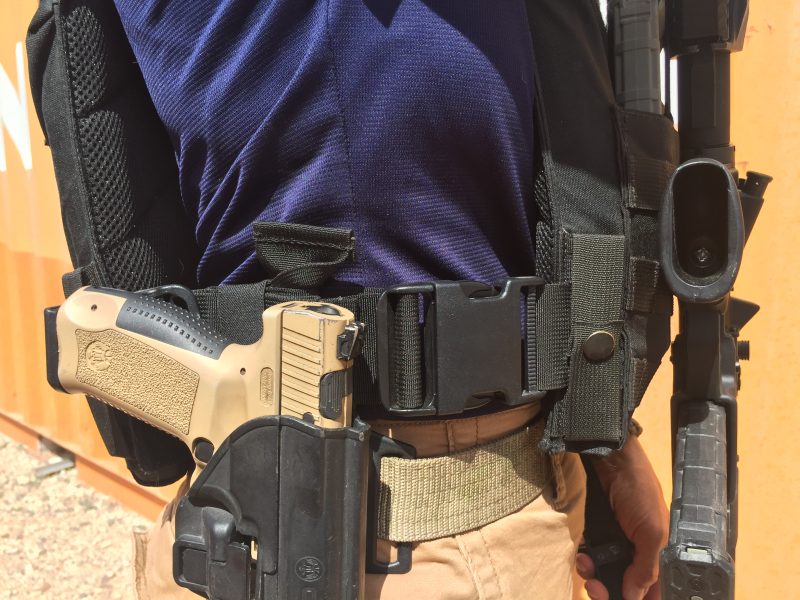Body armor: a primer
Eve Flanigan 09.14.18

September is National Preparedness Month, and crime prevention and survival falls into the realm of preparedness. If life regularly takes you to places where violence is highly possible, wearing body armor may be a good idea. This article is an introduction to body armor basics, with a highlight on the armor I have the good fortune to wear.
Body armor for civilians has become a trend in recent years. Whether the rush to procure this kind of protection is primarily rooted in fear of violent or abuse of power by the state, I don’t know. I do know that a significant number of churches have formed volunteer security programs, with many of them putting in time to learn tactical and emergency medical skills. At the same time, more work sites and gathering places are hiring licensed security guards, some of whom are required to purchase their own gear.
As with selecting a blade or firearm, there is no one type of body armor that’s a panacea. It’s helpful to know types, protection levels, context of use, and cost. It’s also good to understand the limitations of this sort of protection.

Armor rating system
In the United States, body armor testing is conducted, and ratings are established, by the National Institute of Justice (NIJ). Starting with ballistic armor, made to protect wearers from bullet injuries, there are five rating levels. Ballistic plates, also called panels, are the heart of an armor system. A panel is the same thickness throughout and may be flat or slightly curved to match the shape of the torso or other body part it’s made for. These panels’ construction is intended to trap and decelerate, not deflect, bullets. Remember Wonder Woman and her bullet-deflecting bracelets? Had that character been real, a slew of accidental casualties from ricochets would lie in her path. We can’t have that!

Here’s a cursory list of the levels of ballistic protection as tested by NIJ and what caliber(s) each is generally effective in stopping. This is a general view; published standards specify grain weight, muzzle velocity, and whether plates are new or have been exposed to wear or harsh climate conditions. Projectiles that exceed any defined parameter like muzzle velocity, for example, should not automatically be considered “covered” by a given level until tested.
Rating label Caliber
Level IIa 9mm, 40 S&W
Level II 9mm, .357 Magnum
Level IIIa .357 Sig, .44 Magnum
Level III 7.62mm 147 grain FMJ
Level IV .30 caliber armor-piercing 166 grain
Limitations of ballistic armor
A typical ballistic vest with approved plates is designed to protect the heart, spine, kidneys, liver, and spleen. Obviously, there isn’t an armor that can protect all body parts, and the importance of training and access to supplies for stopping blood loss cannot be overemphasized.
Those unfamiliar with ballistic armor might be surprised to realize that it fails to protect the body from stab or slash wounds. Blade-resistant armor is a separate product and is rated by protection level in a similar fashion to ballistic armor. However, it’s near impossible to wear both at once. Evaluate any trends in your geographic area and choose accordingly.
In general, wearing plates can be uncomfortably hot and can make simple tasks like getting in and out of a small car more difficult. It requires effort to organize supplies like a flashlight, pistol, magazines, emergency medical gear, and perhaps handcuffs on or around a plate carrier. The adjustable stock of most AR-platform rifles is an advantage, as it can be shortened to compensate for this extra bulk. Expect to add some training time to your routine when making the transition to wearing a ballistic vest. A quote from Lt. Col. David Grossman applies here: your lifestyle should be comforting, not comfortable.
Finally, while ballistic armor may stop all or most bullets from penetrating a body, their impact can still knock a person down and break bones. Being mentally prepared to stay in the fight and win is necessary.
My own choice
For close to a year now, I’ve been wearing the Gen 2 Active Shooter Kit by T3 Gear, a veteran-owned company in San Diego. This kit includes both ballistic plates and a carrier. It’s ideally suited the civilian-setting security officer or volunteer security, and a good design for preppers as well. It’s less military-looking than many plate carriers, making it easy to wear under an open jacket without attracting attention from afar. It features two 30 round AR-size magazine pouches, plus a pouch that makes for quick access to a tourniquet. Lots of loop material and MOLLE make it possible to hold more.

The Active Shooter kit comes with a cloth, zippered carry case. It’s very adjustable to fit a wide range of body sizes, so could be suited for programs where equipment must be shared or passed down from one user to the next.
Inside the carrier of this setup are two Hessco brand Level IV plates, 10×12 inches in size. They’re gently curved to fit the contour of a torso. I have gone for runs and taught all day at the range wearing this rig, and it’s as comfortable as armor can be. It’s also extraordinarily durable; a hallmark of T3 Gear products is that they’re “made to abuse.” At $349, it’s reasonably priced for rifle-rated protection. The company has other plate carrier styles as well.
I hope this article has given you food for thought on shopping for body armor. While I have perhaps overemphasized the negative aspects of wearing armor, the peace of mind that armor does save lives makes it easy to put the little inconveniences in perspective.

